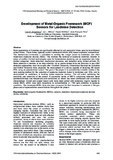- CERES Home
- →
- Cranfield Defence and Security
- →
- Staff publications (CDS)
- →
- View Item
JavaScript is disabled for your browser. Some features of this site may not work without it.
| dc.contributor.author | Humphreys, Lisa | |
| dc.contributor.author | Wilson, Ian | |
| dc.contributor.author | McAteer, Daniel | |
| dc.contributor.author | Pons, Jeff | |
| dc.date.accessioned | 2019-10-31T11:34:51Z | |
| dc.date.available | 2019-10-31T11:34:51Z | |
| dc.date.issued | 2019-07-19 | |
| dc.identifier | http://dspace.lib.cranfield.ac.uk/handle/1826/14660 | |
| dc.identifier.citation | Humphreys L, Wilson I, McAteer D, Pons JF. (2018) Development of metal-organic framework (MOF) sensors for landmine detection. In: 17th International Meeting on Chemical Sensors - IMCS 2018, 15-19 July 2018, Vienna, Austria | en_UK |
| dc.identifier.isbn | 978-3-9816876-9-9 | |
| dc.identifier.uri | https://doi.org/10.5162/IMCS2018/P1AP.8 | |
| dc.identifier.uri | http://dspace.lib.cranfield.ac.uk/handle/1826/14660 | |
| dc.description.abstract | Rural populations in Colombia are significantly affected by anti-personnel mines used by revolutionary armed forces. These mines typically contain ammonium nitrate (AN) based explosive compositions. The international community is committed to tackling the danger posed by landmines and other improvised explosive devices (IEDs). This involves the removal of explosive materials installed in areas of conflict. Current technologies used for humanitarian demining can be separated into three distinct categories; metal detection, mechanical clearance, and detection using trained animals [1]. Metal detection is deemed to be most effective but as plastic-bodied IEDs are now also in use other detection approaches must be sought after. Cranfield University, Universidad Nacional de Colombia and Oxford University have proposed the development of a device capable of detecting AN based IEDs using an optoelectronic sensor. The goal of the project is to establish the scientific validity of the new sensing method for the detection of explosive materials found in landmines and IEDs, and to demonstrate its usefulness in locating buried explosive devices. This will entail optimising the sensitivity and selectivity of the sensor. A systematic series of MOFs comprising transition metal acetates/chlorides and terephthalic acid derivatives as linkers has been synthesised and structurally characterised. Cobalt and copper based salts have been paired with numerous organic ligands to create MOFs which have been responsive to concentrations of ~100 ppm ammonia in aqueous conditions. The developed MOFs have also been assessed for their response to ammonia in the gas phase and at representative concentrations throughout the project. | en_UK |
| dc.language.iso | en | en_UK |
| dc.publisher | AMA Service GmbH | en_UK |
| dc.rights | Attribution-NonCommercial 4.0 International | * |
| dc.rights.uri | http://creativecommons.org/licenses/by-nc/4.0/ | * |
| dc.subject | metal-organic frameworks (MOFs | en_UK |
| dc.subject | improvised explosive devices (IEDs) | en_UK |
| dc.subject | ammonia | en_UK |
| dc.subject | Sensors | en_UK |
| dc.title | Development of metal-organic framework (MOF) sensors for landmine detection | en_UK |
| dc.type | Conference paper | en_UK |
Files in this item
The following license files are associated with this item:
This item appears in the following Collection(s)
-
Staff publications (CDS) [1222]

